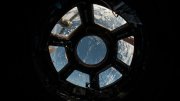Reflecting on dance's contributions to her own life—cultural appreciation, artistic expression, improved self-esteem and body image—Anna Else Pasternak ’07 decided to start a program to teach dance at an orphanage outside Panama City. Read about Pasternak and her program in "Street-level Ballet," from the May-June 2011 issue.
To learn more about Pasternak's program, Movement Exchange, watch this six-minute introduction, including interviews with Movement Exchange participants:
See highlights from the performance at Panama's National Theater on July 4, 2010:








